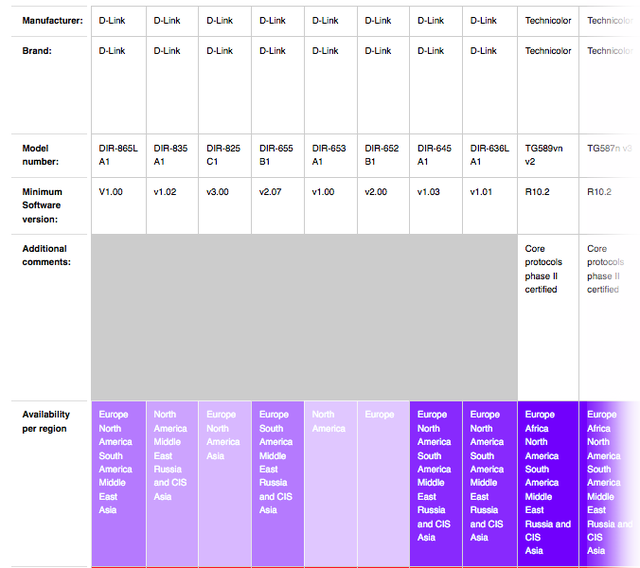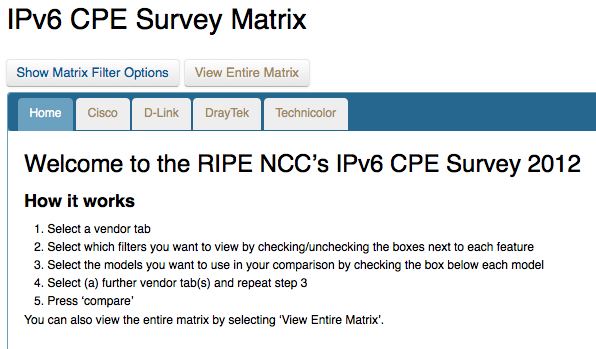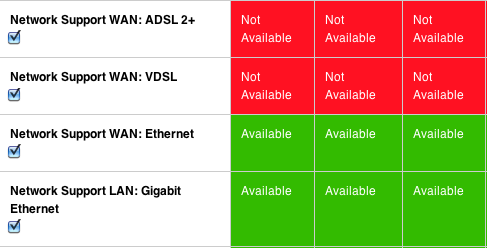In response to a huge amount of demand, the RIPE NCC has conducted another survey on the level of IPv6 support for various vendor's Customer Premises Equipment (CPE). The questions in the 2012 focused around the most common access technologies. The results have been published using a simple colour coded matrix, listing which features are present, on the roadmap or not available. We've also developed a new interactive user interface so you're now able to filter the results and compare different models. This article will highlight some of the 2012 findings as well as some comparison to previous editions of the survey.
History
The first IPv6 Customer Premise Equipment (CPE) Survey was released in June 2010 and found a home here on RIPElabs. The actual work on the survey, however, started far earlier, back in 2008. It soon became clear that CPE was a very hot topic for the technical community and so we decided to update the CPE Survey matrix
The 2012 Survey
Over time we've learned one key lesson: it's almost impossible to fully determine whether a specific feature is operating as expected or not. Too many external factors and differences in the definitions makes it really hard to put concrete values on things. User reports and trying to determine if features were indeed working was probably the most controversial part of the previous surveys.
Although several people offered their help, both with manpower and equipment, we decided to skip the tests. It's impossible to test every single combination and we also didn't want to duplicate work; projects like KATR and the GetIPv6.info wiki already do a great job collecting user feedback and test results.
So, for the 2012 survey, we asked the vendors to list what is available and what is planned for the future.
How to use it
The survey can be used as a buying guide to find out which models might suit your needs. Get a few of the models you like and test them in your own network, using the access technology and transitioning method you choose.
We know that for a home user "getting a few" is not a solution. If you are looking at the survey to find a router for your home setup, consult your service provider on the features you need. When you buy one, make arrangements with the shop, so that you can return the device in case it turns out that it doesn't suit your needs.
You can select which models from which vendor and which features you want to compare in the new interactive interface. You can also view the overall matrix which contains all the results.
Regional Availability
People from all over the world have shown interest in this work. At the same time we noticed differences in the level of IPv6 support based on where you buy a certain device. So we asked the participants to indicate in which region certain models are available. In making this a selectable item, we hope to have added a valuable new feature to the survey interface. Some vendors have the same model available globally, others show large differences between the models available in different parts of the world. See below a part of the IPv6 CPE table showing regional availability:

Comparing the results
When we first started the CPE survey work, there were hardly any consumer grade devices available and what was there was often still in the early stages of development. Today, most of the major vendors offer multiple devices that come with IPv6 enabled by default, straight out of the box.
And although the number of networks that offer IPv6 is still fairly small, we see more and more network operators announcing plans to deploy IPv6 or who are already doing small scale consumer testing. This also helps a lot in telling the manufacturers where to focus their developments. At the same time it helps other operators in choosing a particular provisioning method or access technology.
IPv6 transition technologies
With APNIC and the RIPE NCC already allocating address space from their last /8s, the 2012 CPE Survey was conducted in a different environment to the previous surveys and a lot of people have asked about CPE support for transitioning technologies.
We didn’t include any of these transitioning technologies in this survey. We strongly believe that a full and native deployment of IPv6 should be the goal. Providing people access without any dependency on other protocols like IPv4 is the most important. No matter which intermediate solution you deploy. Make sure it is future proof. That also goes for the CPE you pick, make sure you can turn off IPv4 at some point in time.
The other and even more important reason is that we did not want to overload the survey. There are just too many options to include them all and none of them has become really dominant. In other words, we don’t have clear picture of what exactly we should ask. You can find more information about current transition mechanisms on IPv6ActNow.org .
Wireless Technology
The same goes for wireless. In the past, a lot of people asked us to include LTE and 3G devices. While we see a definite move towards IPv6 on such devices in the last few months, we feel it is too early to list them. Only a few networks today support IPv6 and developments in the industry are so fast, that by the time we published the first survey, a lot of the information may be outdated.
Conclusion
The conclusion can be short: “CPE that support IPv6 are available from multiple sources”. And while we don’t list them in the survey we have also seen various proprietary models that now support IPv6. The message is clear: there's now no excuse not to deploy IPv6.
The real challenge comes now as people have to buy and install CPE and replace the millions of devices that are already out there and which are fast becoming obsolete.
The IPv6 CPE Survey 2012 can be accessed via the IPv6 Act Now website,
See below a screenshot of the main survey page.

Feedback
As with the previous surveys, your feedback is important. Tell us what you think and which questions or features we should include in any future versions of this survey.
We also would like invite all manufacturers to participate in this project. If you haven’t been contacted by the RIPE NCC yet, please contact us via ipv6actnow@ripe.net and we will send you the questionnaire and information on how to get your equipment listed.







Comments 7
The comments section is closed for articles published more than a year ago. If you'd like to inform us of any issues, please contact us.
default •
Have you asked AVM about the Fritz!Box series? Availability might be limited (Germany/Europe for the most part), but IPv6 support should be top-notch. As far as I know Fritz!Boxes they were among the very first CPEs to offer IPv6; AVM initially offered support for some models in 2009, and nowadays all current models support IPv6 by default.
MarcoH •
Yes, as mentioned in the presentation both NEC and AVM have already submitted data. Unfortunately too late for release, we hope to add them this week after things have settled down a bit.
MarcoH •
Good news from our webteam, both AVM and NEC have been added today
Witek •
Hi, I know Mikrotik isn't exactly consumer level devices, but some models are quite cheap (90$), so can easly be clasified as consumer. Older models handle IPv6 after free upgrade, and some of newer ones handle IPv6 out of the box (or after firmware upgrade if you are unlucky to get device with old firmware). Could you please test it? They are really interesting devices, not only for ISP, but also for home and office usage. For example I use Mikrotik RouterBoard RB493G (about 250$ with wifi card) in home, and it support IPv6. There is about 20 other models, and I belive all of them support IPv6 in same way. Documentation http://wiki.mikrotik.com/wiki/Manual:IPv6
Mirjam Kühne •
Dear Witek, unfortunately we don't have the resources and infrastructure anymore to test any devices. If you know who in Microtik would be able to answer our survey questions, please introduce us to them and we will be happy to get in touch with them.
Ragnar Anfinsen •
Hi. I would like to see a field in the survey showing whether 6rd (RFC5969) is supported or not. I can't find any relation to it right now.
Ross Chandler •
Has anyone heard of a residential CPE that supports a stateful firewall (RFC 6092)? There are a good few CPE vendors now with the basic IPv6 networking support but the level of firewall implementations is still bad.